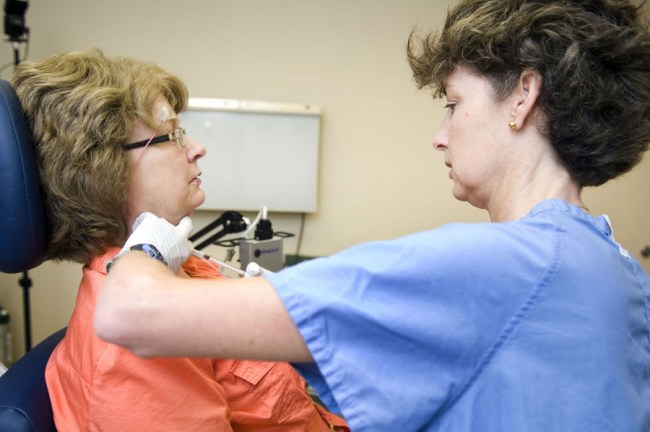
Gaelyn Garrett, M.D., injects Botox into the muscle of patient Lisa McGuire's vocal folds to help address her spasmodic dysphonia. (photo by Susan Urmy)
Rare vocal condition makes speaking a challenge
Lisa McGuire was ordering an ice cream sundae for her daughter at a McDonald’s drive-thru window when she first realized something was very wrong with her voice.
“I was trying to say ‘No nuts,’” she recalled. “And I couldn’t get it across. He finally said, ‘I’m sorry, I can’t understand you,’ and I had to pull up to the window.”
More than three years later McGuire is receiving her 13th Botox injection into the muscle of her vocal folds, the gold standard of treatment for a rare neurological disease known as spasmodic dysphonia (SD).
SD patients typically speak with catches or breaks in their voice, seemingly ending words and sentences abruptly, which can make everyday conversation somewhat uncomfortable for both parties.
“It is a very tight, strangled sounding quality, and the more severe it is the more it affects their ability to communicate,” said Brienne Ruel, a speech-language pathologist at the Vanderbilt Voice Center.
“Their old voice is really gone to a degree and there tends to be a big social impact. People ask … 'are you sick? What happened to your voice? Why can’t you just talk like you used to?' And there is no real answer for them other than ‘I am not doing this on purpose.’”
Vanderbilt treats roughly 400 of the 30,000 SD patients in the United States, some traveling here from as far away as New Mexico to receive treatment for the condition that has no known cure, although routine Botox injections do provide relief for most patients if repeated every three months.
The Voice Center, in cooperation with the National Spasmodic Dysphonia Association, is hosting an inaugural Nashville Spasmodic Dysphonia Symposium this Saturday, June 20, from 9 a.m. to 3 p.m. in Vanderbilt Medical Center East lecture hall 8380.
Diagnosing SD patients is still very difficult, so it is not uncommon for some people to go for years without the correct diagnosis, and therefore, without the correct treatment.
The onset of SD can be gradual or sudden, occurring in patients as young as 13 years old but more typically between ages 40 and 50.
“Some people attribute it to a bad bout of laryngitis or allergies or to trauma, and some people attribute it to a high period of stress,” Ruel said.
“There is no link yet to exactly what might be a factor that initiates the onset.”
McGuire was originally diagnosed with laryngitis and then vocal abuse before her condition progressed.
“With spasmodic dysphonia, people struggle trying to figure out what is wrong with them,” McGuire said. “The big clue is the the struggle to talk on the telephone and at the drive-thru. I was actually diagnosed over the phone.”
Like many SD patients, McGuire had trouble working and retired early after 20-plus years as a choir director and 28 years as a speech-language pathologist in schools.
“I retired early from my career in speech therapy, mainly out of frustration,” she said. “I struggled with teaching articulation skills to my students.”
SD comes from a family of disorders known as dystonias that affect various muscle groups in the body including the neck, extremities and vocal cord muscles.
“The involved muscles are overactive and tend to spasm with particular activities,” said Gaelyn Garrett, M.D., medical director for the Voice Center.
“These disorders originate in the brain in the same area that affects those with Parkinson's disease. In fact, people with a dystonia can often relate to other family members with Parkinson's or other types of movement disorders such as tremor.”
Barbara Biehler is one of four persons in her family who suffer from general dystonias.
She has battled the disorders since age 11 and received Deep Brain Stimulation surgery at Vanderbilt in 2005 to treat her arms and hands.
Biehler, 50, has noticed improvement with her movement issues but the condition has since spread to her voice, which she says is the most challenging.
“Communication is the basis of human instinct and if you can’t communicate with other people you end up being more socially isolated than you would like,” Biehler said.
“With dystonia, it takes a lot of effort for me to speak clearly, not to mention to get people to listen to me. You are always competing with environmental factors like the television being up too loud or a crowded restaurant. Even with my family I am always saying, ‘come to me so you can hear me,’ or ‘turn down the TV’ … ‘work with me here, people.’”
For more information or to register for the conference, contact Ruel at 343-5871.













